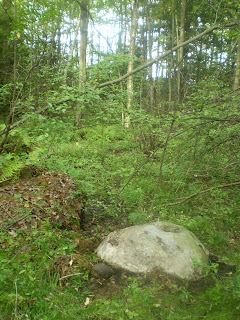I made a few posts in 2008 at Rock Piles about the "Turtle Shaped" boulder mortar pictured above. Take a look here: http://rockpiles.blogspot.com/2008/09/teaser-pix.html for the old posts, with more at: http://rockpiles.blogspot.com/2008/09/return-to-mortarturtle-part-one.html
In among all those "bowlder” pics I took back then were these two photos:
See: I had no cover to sneak into the place where I was originally trespassing into in the Industrial Park to get to the boulder, so I was following the stream and its zigzag stone riparian zone borders, back in 2008 to get there "under cover." I don’t know why I took these photos at the time; I would have for a reason if I had walked there today.
See: Out in Northern California, my friend Alyssa Alexandria tells me she finds these Offering Basins or Offering Baskets quite often. I had spotted a few in photos from Ron Smith’s website and had been wondering about them, looking into documentation about them.
(Which is really: "Off Pass Road in the Sutter Buttes. ~ Ron Smith)
(Now a dead link...)
7/8/2022: Chile Verde photos
Below pondered at: http://wakinguponturtleisland.blogspot.com/2010/09/what-is-it.html
There were more:
Each of these is probably a "luck basin/rock bowl/rock basket."
I had found reference to them here first as below:
"This medicine was to be used at a special "luck basin" that Shoemaker knew about. This term refers to a basinlike depression in a rock formation, and the Hupa word for it is translated into English as "rock bowl" or "rock basket" (Golla, in press [MS p. 214]). The use of a luck basin for success in gambling is described as follows: When you find such a place you must "smoke" it with incense root and speak to it. You smoke it for ten days and talk to it about the people you're going to gamble with, and how many points you want to make in a stretch, and so on. Then you clap your hands to it, and leave some incense root in it. When you are ready to gamble, you go up to it and rub your hands with the incense root. (Golla, in press [MS p. 213])" http://publishing.cdlib.org/ucpressebooks/view?docId=ft8g5008k8&chunk.id=d0e1239&toc.id=d0e310&brand=eschol
Keeling, Richard. Cry for Luck: Sacred Song and Speech Among the Yurok, Hupa, and Karok Indians of Northwestern California. Berkeley: University of California Press, c1992 1992. http://ark.cdlib.org/ark:/13030/ft8g5008k8/
I found more recently that they are also called “Spirit Baskets” (and even a different sort of “Pain Basket” that isn't mortar-like) by the Maidu:
“The statement is made, moreover, by the Indians, that finished, widely and deeply excavated globular mortars were found by them in certain localities in considerable numbers. These localities were gravel-banks along the edges of streams, the stream-beds themselves, or the surface of the ground in certain stony places. They claim that in a few spots large numbers of mortars were to be found; and some declare that the shamans know where these spots are, and go there at times to secure mortars, which, as will be seen later in speaking of religious ceremonials, were used for various mysterious and sacred purposes. Everywhere throughout the Northern Maidu area these mortars are regarded with considerable awe and veneration, and are feared quite keenly in many instances. Apart from their ceremonial uses, every family is anxious to own a mortar; but it is never kept in the house or near it, being generally buried some distance away, and occasionally dug up and examined.
Mortars were used by the shamans as receptacles in which to keep their most powerful and precious charms, especially the "pains" which they shot at people to cause disease or death. Such "pains" were kept in a mortar, with another mortar inverted over the first, the whole carefully secreted in a hollow log or under a large stone at a considerable distance from all habitations or trails. In the initiation ceremonies of the Secret Society the sacred meal used for sprinkling the novices must similarly be kept in a mortar. Lastly, the mortars are generally known by the name of ku'kinim to'nior i'tum to'ni ("spirit or pain baskets"), and are often supposed to be themselves the abiding-places of powerful spirits; although the belief in the mortars' animation, and their ability to move of their own accord from place to place, is not held here, as it is among the Shasta. By some the mortars are said to have been made by the Creator, or the Coyote, at the time of the creation, and scattered over the world for the use of mankind. By others they are supposed to have been people originally, during the bSte'ito, or time of the "first people," who were turned into stone in this form at the coming of the Indian people, when the other "first people" became animals.”
Bulletin of the American Museum of Natural History, Volume 17
By Joel Asaph Allen, American Museum of Natural History
http://books.google.com/books?output=text&id=hYNCAAAAYAAJ&dq=shaman+mortar&jtp=136
Alyssa Alexandria’s photos of some of these boulders close up:
Here are three possible similar such “Medicine Bowlders” - a combination of words I just came up with - in Woodbury CT:
So I'm on the look out for these, and if you happen across one, please take a photo and send one in...


















Here are 3 examples found within a 200 acre area in Massachusetts. Please feel free to use them, this area has great Manitou:
ReplyDeletehttp://tracesinthewoods.blogspot.com.es/2011/08/native-american-grinding-stones.html